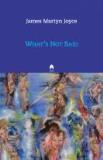Would The Real Mr Joyce Please Stand Up

first reading of James Martyn Joyce’s first collection of short stories entitled “What’s Not Said”, just published by Arlen House, you could be forgiven for thinking that it is the work of yet another “Angry Young Man” reacting in disgust and horror to the cynical and hypocritical world he finds himself living in where everything is brushed under the proverbial carpet and what’s not said is better than saying anything at all. Nothing could be further from the truth.
On the contrary, the author is a much loved and respected retired school principle and is somewhat diffident and surprisingly shy. Curiously, this fact makes the collection challenging, more elusive and much more interesting.
There is no doubt that, again, at first reading the collection is rife with extreme and casual violence, callous murder and wanton destruction. Even when violence is not physically present on the page, it simmers beneath the surface always ready, at the turn of a sentence, to express itself in all its gory detail.
The first three stories would give the lie to the previous statement if only because of the apparent lack of violence in them. In exploring the moral apathy and social confusion of post Celtic Tiger Ireland, Joyce underlines the resultant vacuum that threatens the fabric of Irish society as it gives rise to a drug and alcohol culture in which human values are eroded and life is cheap.
In the third of these stories, “Angleground”, Joyce reaches something of a crossroads as he unveils the cultural chasm that now exists in Ireland. On the one hand there is Tommy who, while agreeing reluctantly to accept progress by gradually selling off his fields – “more money than he ever knew flowing into his accounts” – only does so on the unwritten guarantee that the heart of these fields, the little wood, be preserved for communal use, on the other hand, the young Cooley who, having failed to make his fortune in Manchester, sees in the same plot of land his only chance to resurrect his future. The resultant Mexican standoff leads to the self inflicted annihilation of the one and the ultimate failure of the other.
Suddenly the stories enter into a world of failure, disillusion, confusion, despair and low self esteem where the rules, if there are any, keep on changing. Society is being turned on its head, anarchy beckons, and a hideous downward spiral begins finally exploding with the flick of a burning match on a stream of spilt petrol and bringing on the final catharsis. After that there is a brief interlude where the new generation in no uncertain terms claim their tarnished inheritance.
Then, and only then, does Joyce draw breathe and cools it all down with the final and key story “!927 –Hat” which brings a strange if not eerie calm to the whole collection and demonstrates that in the art of “What’s Not Said” the Irish are past masters.
The stories in “What’s Not Said” are not everybody’s cup of tea, but they are certainly thought provoking. Like all collections, some are better than others. “Angleground” strikes a deep chord while “1927 –Hat” stands shoulder to shoulderl with any of the classic Irish Civil War stories. On the other hand some of the stories are confusing imbued with a touch of hysteria especially when the inherent violence turns on itself.
As a teacher, Joyce lays down a marker in these stories suggesting that perhaps more honesty is needed and that the “We are all right Jack” philosophy is not to be trusted. As a writer he obviously delights in exploring the human condition especially when the defence systems it has created for itself have failed and its moral status is being threatened. Somewhere in the middle there is the real Mr Joyce and I, for one, look forward to seeing what comes next.
